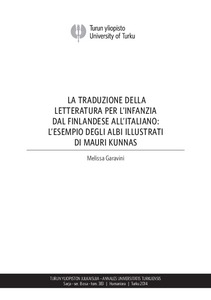La traduzione della letteratura per l’infanzia dal finlandese all’italiano: l’esempio degli albi illustrati di Mauri Kunnas
Garavini Melissa
https://urn.fi/URN:NBN:fi-fe2021042715052
Tiivistelmä
Despite the increasing number of research on translating for children, no study has so far
taken into consideration the translations of children’s literature from Finnish into Italian. This
dissertation sets out to fill this gap with a comparative study of Finnish picturebooks and their
translations into Italian. Besides being the first research in the field analysing the shifts
between these two systems, the study thoroughly investigates the characteristics of the
translation process of picturebooks. The works chosen as case study are the Finnish
picturebooks by Mauri Kunnas and their Italian translations from the period 1979-2009
because they are characterized by a high number of linguistic and cultural complexities which
challenge translators’ skills and knowledge.
The dissertation establishes whether and how culture-specific elements (anthroponyms,
toponyms, food and allusions) and the word-image interaction have a significant impact on
the quality and the nature of the target works, and also whether these aspects are still
consistent after the translation and the adaptation process to the target system. Since
picturebooks are multimodal texts whose message is produced by both the verbal and the
visual, it has been necessary to use a multimodal comparative analysis. Such a descriptive
comparative study has allowed me to describe the textual and cultural manipulations
undergone by Kunnas’s picturebooks translated into Italian. Indeed, it has helped to identify
what kind of shifts occur when cultural specific elements are transferred from the source
system to the target one, to determine the most frequent translation strategies used to ensure a
higher degree of readability, and to establish whether particular translation choices have
contributed to modify the word-image interaction.
The results of the multimodal comparative analysis have shown that Italian translators have
been deeply influenced by the preponderance of the illustrations and for this reason they have
often verbalised the visual and added information not originally contained in the source
written text. Moreover, the findings of the analysis together with the interviews to the Italian
translator and publishing house have also demonstrated that the latter aimed at producing
works “good for the child” – and at the same time “good for the adult” – and at minimising
Finnish cultural specificity, even to the detriment of the aesthetic nature of the original
picturebooks.
Kokoelmat
- Rinnakkaistallenteet [27094]
